Auditing and Assurance Services: Technology, Ethics and Quality Report
VerifiedAdded on 2022/11/22
|13
|3395
|307
Report
AI Summary
This report examines the critical issues surrounding audit quality, particularly in the context of technological advancements and ethical considerations within the auditing and assurance services sector. It delves into the application of technologies like artificial intelligence, data visualization, and robotics to improve auditing processes, highlighting their benefits and potential. The report also explores the significance of a restructured code of ethics in maintaining public interest, discussing key principles like integrity, objectivity, and confidentiality. Furthermore, it addresses the impact of ethical scandals, such as the Enron case, and the role of regulatory bodies like ASIC in ensuring audit quality. The report also discusses the importance of skepticism and the IESBA's role in developing ethical standards, along with the implications of non-compliance with laws and regulations, providing a comprehensive overview of the evolving landscape of auditing and assurance services.
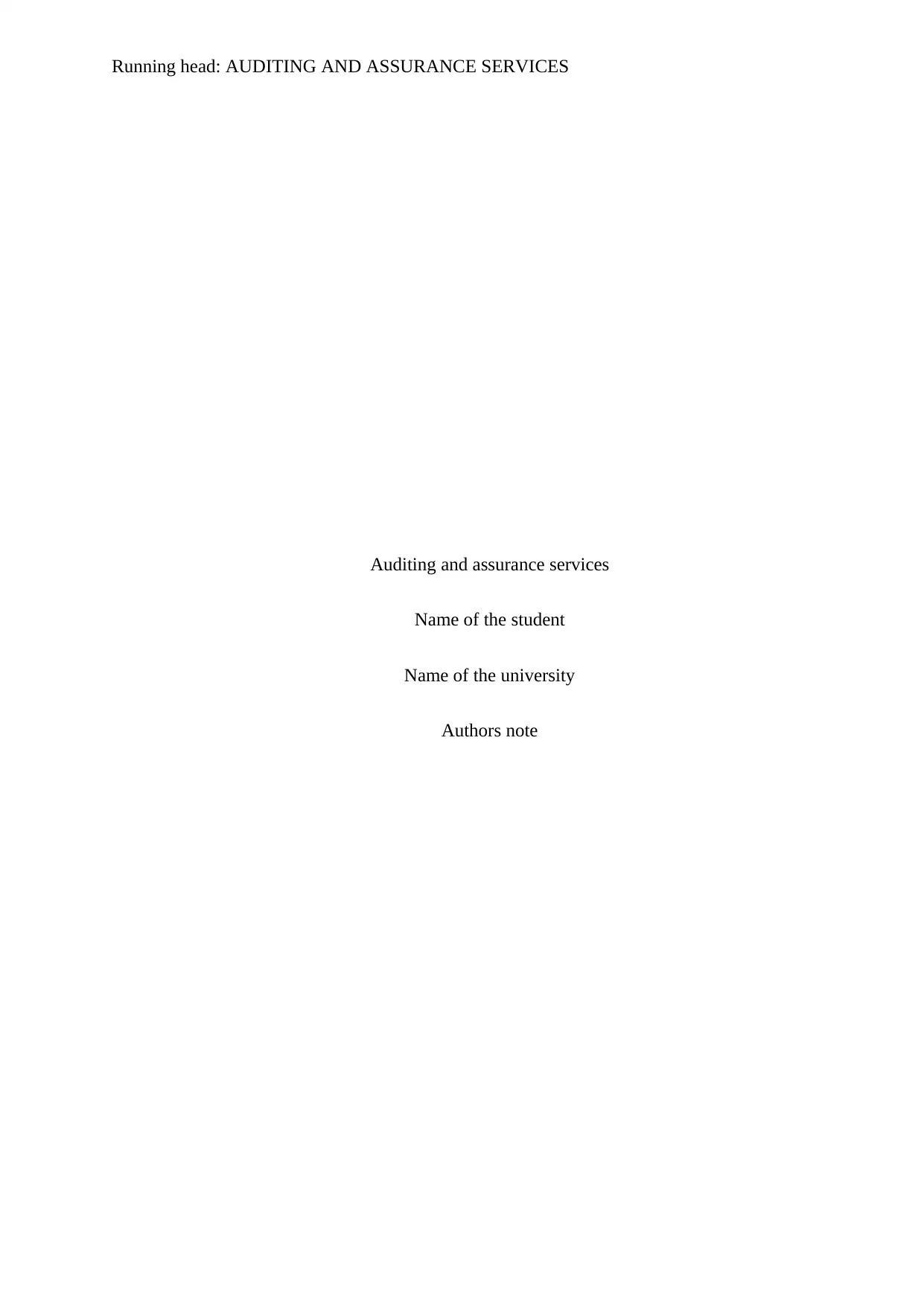
Running head: AUDITING AND ASSURANCE SERVICES
Auditing and assurance services
Name of the student
Name of the university
Authors note
Auditing and assurance services
Name of the student
Name of the university
Authors note
Paraphrase This Document
Need a fresh take? Get an instant paraphrase of this document with our AI Paraphraser
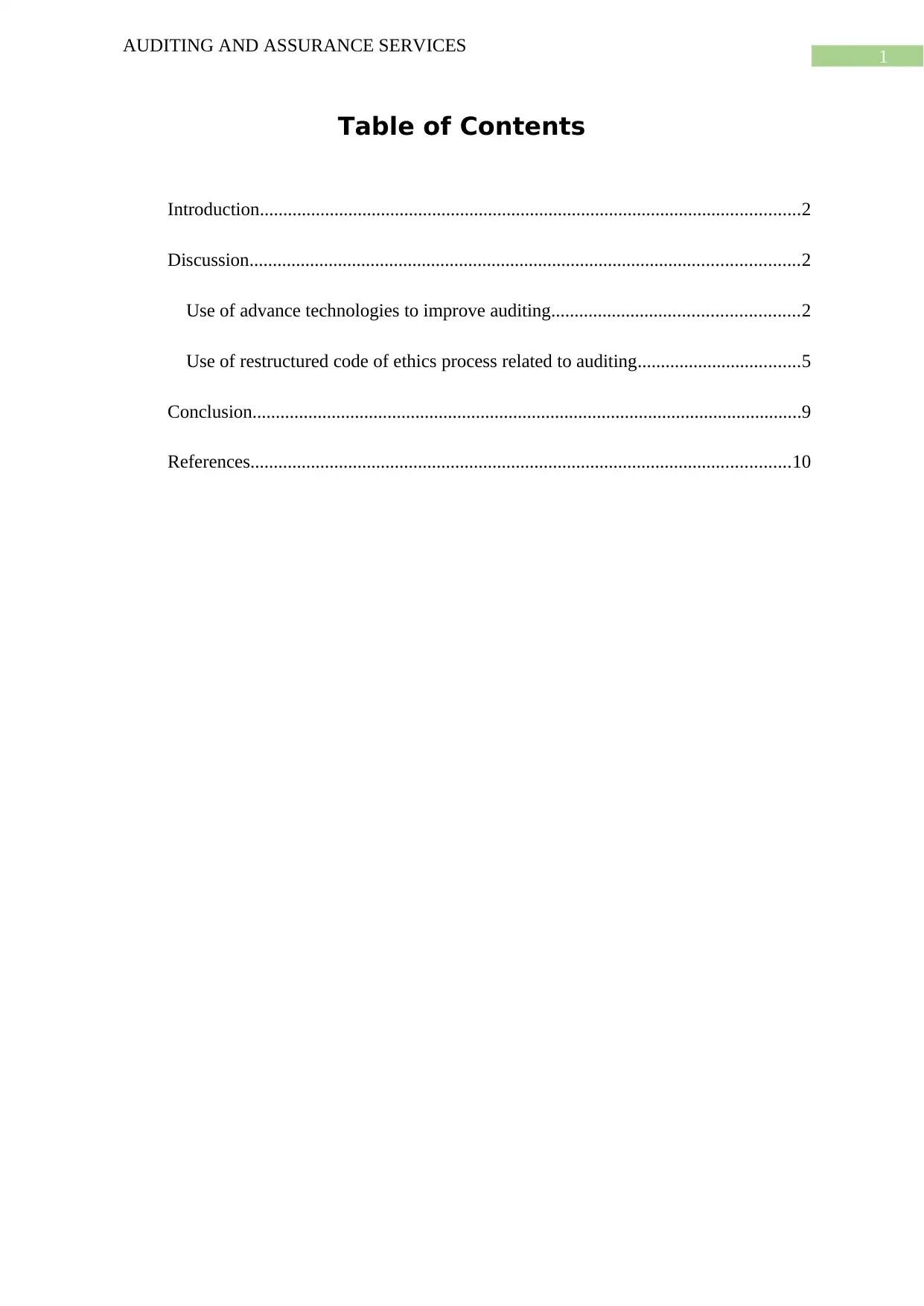
1
AUDITING AND ASSURANCE SERVICES
Table of Contents
Introduction....................................................................................................................2
Discussion......................................................................................................................2
Use of advance technologies to improve auditing.....................................................2
Use of restructured code of ethics process related to auditing...................................5
Conclusion......................................................................................................................9
References....................................................................................................................10
AUDITING AND ASSURANCE SERVICES
Table of Contents
Introduction....................................................................................................................2
Discussion......................................................................................................................2
Use of advance technologies to improve auditing.....................................................2
Use of restructured code of ethics process related to auditing...................................5
Conclusion......................................................................................................................9
References....................................................................................................................10
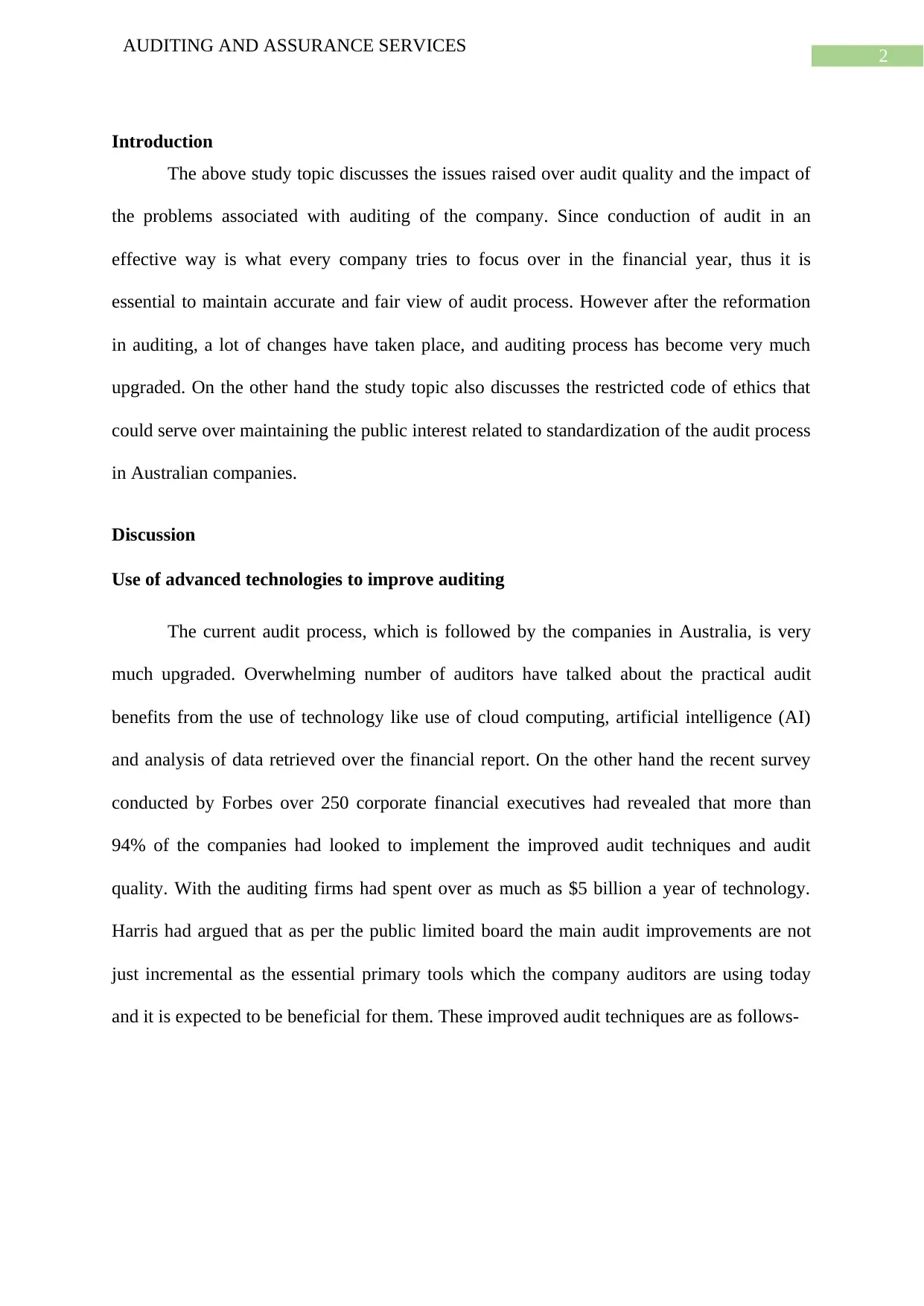
2
AUDITING AND ASSURANCE SERVICES
Introduction
The above study topic discusses the issues raised over audit quality and the impact of
the problems associated with auditing of the company. Since conduction of audit in an
effective way is what every company tries to focus over in the financial year, thus it is
essential to maintain accurate and fair view of audit process. However after the reformation
in auditing, a lot of changes have taken place, and auditing process has become very much
upgraded. On the other hand the study topic also discusses the restricted code of ethics that
could serve over maintaining the public interest related to standardization of the audit process
in Australian companies.
Discussion
Use of advanced technologies to improve auditing
The current audit process, which is followed by the companies in Australia, is very
much upgraded. Overwhelming number of auditors have talked about the practical audit
benefits from the use of technology like use of cloud computing, artificial intelligence (AI)
and analysis of data retrieved over the financial report. On the other hand the recent survey
conducted by Forbes over 250 corporate financial executives had revealed that more than
94% of the companies had looked to implement the improved audit techniques and audit
quality. With the auditing firms had spent over as much as $5 billion a year of technology.
Harris had argued that as per the public limited board the main audit improvements are not
just incremental as the essential primary tools which the company auditors are using today
and it is expected to be beneficial for them. These improved audit techniques are as follows-
AUDITING AND ASSURANCE SERVICES
Introduction
The above study topic discusses the issues raised over audit quality and the impact of
the problems associated with auditing of the company. Since conduction of audit in an
effective way is what every company tries to focus over in the financial year, thus it is
essential to maintain accurate and fair view of audit process. However after the reformation
in auditing, a lot of changes have taken place, and auditing process has become very much
upgraded. On the other hand the study topic also discusses the restricted code of ethics that
could serve over maintaining the public interest related to standardization of the audit process
in Australian companies.
Discussion
Use of advanced technologies to improve auditing
The current audit process, which is followed by the companies in Australia, is very
much upgraded. Overwhelming number of auditors have talked about the practical audit
benefits from the use of technology like use of cloud computing, artificial intelligence (AI)
and analysis of data retrieved over the financial report. On the other hand the recent survey
conducted by Forbes over 250 corporate financial executives had revealed that more than
94% of the companies had looked to implement the improved audit techniques and audit
quality. With the auditing firms had spent over as much as $5 billion a year of technology.
Harris had argued that as per the public limited board the main audit improvements are not
just incremental as the essential primary tools which the company auditors are using today
and it is expected to be beneficial for them. These improved audit techniques are as follows-
⊘ This is a preview!⊘
Do you want full access?
Subscribe today to unlock all pages.

Trusted by 1+ million students worldwide
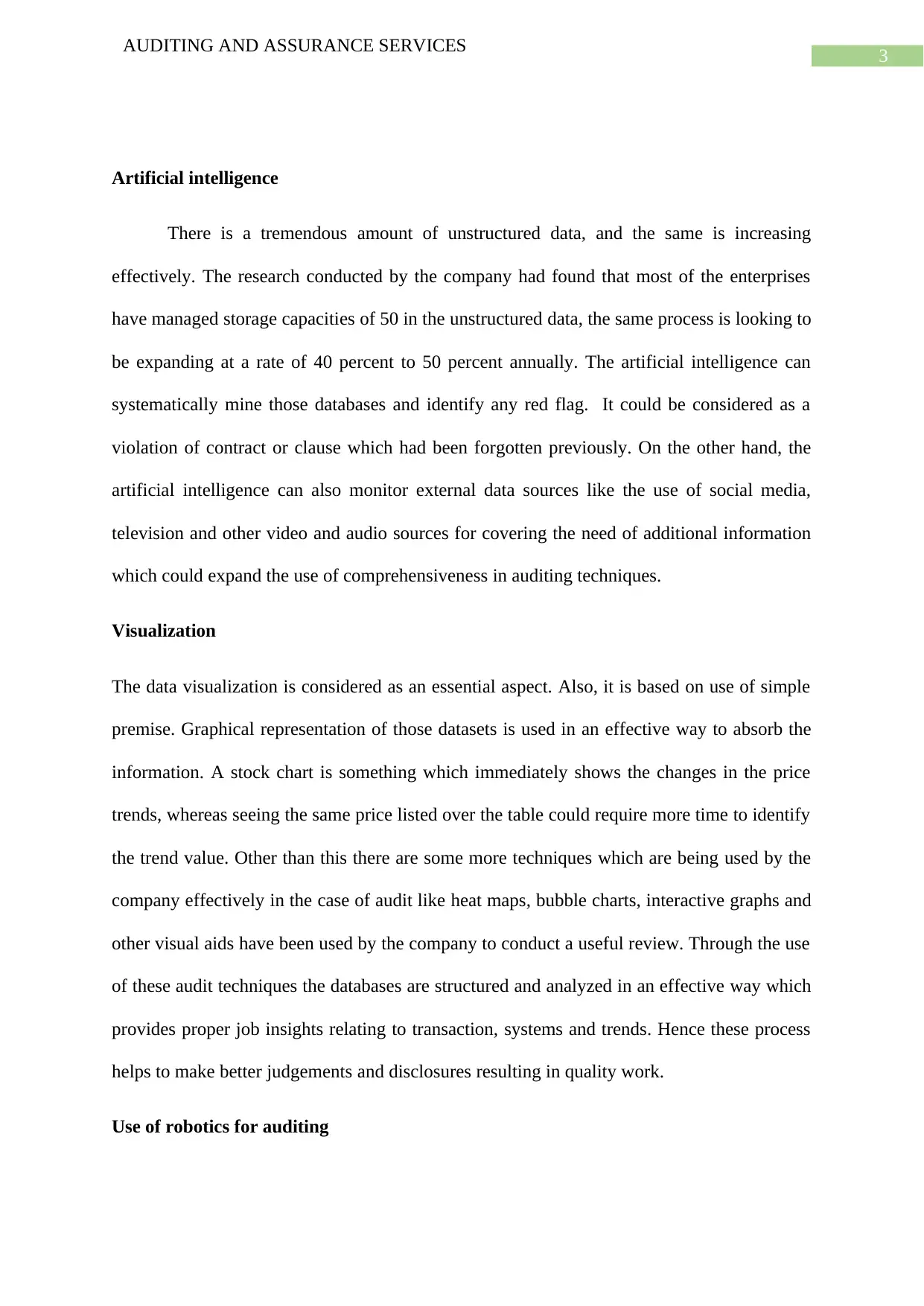
3
AUDITING AND ASSURANCE SERVICES
Artificial intelligence
There is a tremendous amount of unstructured data, and the same is increasing
effectively. The research conducted by the company had found that most of the enterprises
have managed storage capacities of 50 in the unstructured data, the same process is looking to
be expanding at a rate of 40 percent to 50 percent annually. The artificial intelligence can
systematically mine those databases and identify any red flag. It could be considered as a
violation of contract or clause which had been forgotten previously. On the other hand, the
artificial intelligence can also monitor external data sources like the use of social media,
television and other video and audio sources for covering the need of additional information
which could expand the use of comprehensiveness in auditing techniques.
Visualization
The data visualization is considered as an essential aspect. Also, it is based on use of simple
premise. Graphical representation of those datasets is used in an effective way to absorb the
information. A stock chart is something which immediately shows the changes in the price
trends, whereas seeing the same price listed over the table could require more time to identify
the trend value. Other than this there are some more techniques which are being used by the
company effectively in the case of audit like heat maps, bubble charts, interactive graphs and
other visual aids have been used by the company to conduct a useful review. Through the use
of these audit techniques the databases are structured and analyzed in an effective way which
provides proper job insights relating to transaction, systems and trends. Hence these process
helps to make better judgements and disclosures resulting in quality work.
Use of robotics for auditing
AUDITING AND ASSURANCE SERVICES
Artificial intelligence
There is a tremendous amount of unstructured data, and the same is increasing
effectively. The research conducted by the company had found that most of the enterprises
have managed storage capacities of 50 in the unstructured data, the same process is looking to
be expanding at a rate of 40 percent to 50 percent annually. The artificial intelligence can
systematically mine those databases and identify any red flag. It could be considered as a
violation of contract or clause which had been forgotten previously. On the other hand, the
artificial intelligence can also monitor external data sources like the use of social media,
television and other video and audio sources for covering the need of additional information
which could expand the use of comprehensiveness in auditing techniques.
Visualization
The data visualization is considered as an essential aspect. Also, it is based on use of simple
premise. Graphical representation of those datasets is used in an effective way to absorb the
information. A stock chart is something which immediately shows the changes in the price
trends, whereas seeing the same price listed over the table could require more time to identify
the trend value. Other than this there are some more techniques which are being used by the
company effectively in the case of audit like heat maps, bubble charts, interactive graphs and
other visual aids have been used by the company to conduct a useful review. Through the use
of these audit techniques the databases are structured and analyzed in an effective way which
provides proper job insights relating to transaction, systems and trends. Hence these process
helps to make better judgements and disclosures resulting in quality work.
Use of robotics for auditing
Paraphrase This Document
Need a fresh take? Get an instant paraphrase of this document with our AI Paraphraser
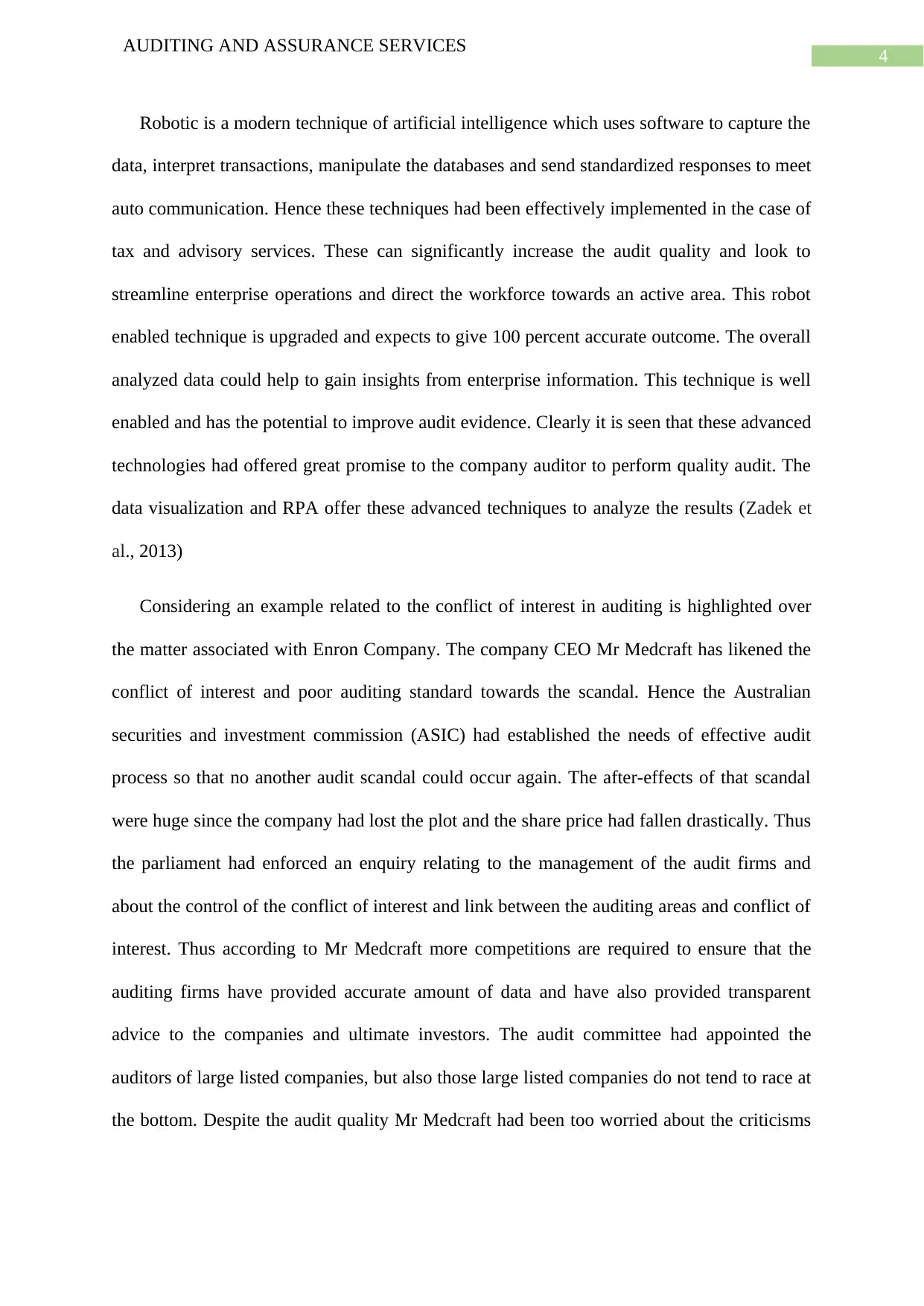
4
AUDITING AND ASSURANCE SERVICES
Robotic is a modern technique of artificial intelligence which uses software to capture the
data, interpret transactions, manipulate the databases and send standardized responses to meet
auto communication. Hence these techniques had been effectively implemented in the case of
tax and advisory services. These can significantly increase the audit quality and look to
streamline enterprise operations and direct the workforce towards an active area. This robot
enabled technique is upgraded and expects to give 100 percent accurate outcome. The overall
analyzed data could help to gain insights from enterprise information. This technique is well
enabled and has the potential to improve audit evidence. Clearly it is seen that these advanced
technologies had offered great promise to the company auditor to perform quality audit. The
data visualization and RPA offer these advanced techniques to analyze the results (Zadek et
al., 2013)
Considering an example related to the conflict of interest in auditing is highlighted over
the matter associated with Enron Company. The company CEO Mr Medcraft has likened the
conflict of interest and poor auditing standard towards the scandal. Hence the Australian
securities and investment commission (ASIC) had established the needs of effective audit
process so that no another audit scandal could occur again. The after-effects of that scandal
were huge since the company had lost the plot and the share price had fallen drastically. Thus
the parliament had enforced an enquiry relating to the management of the audit firms and
about the control of the conflict of interest and link between the auditing areas and conflict of
interest. Thus according to Mr Medcraft more competitions are required to ensure that the
auditing firms have provided accurate amount of data and have also provided transparent
advice to the companies and ultimate investors. The audit committee had appointed the
auditors of large listed companies, but also those large listed companies do not tend to race at
the bottom. Despite the audit quality Mr Medcraft had been too worried about the criticisms
AUDITING AND ASSURANCE SERVICES
Robotic is a modern technique of artificial intelligence which uses software to capture the
data, interpret transactions, manipulate the databases and send standardized responses to meet
auto communication. Hence these techniques had been effectively implemented in the case of
tax and advisory services. These can significantly increase the audit quality and look to
streamline enterprise operations and direct the workforce towards an active area. This robot
enabled technique is upgraded and expects to give 100 percent accurate outcome. The overall
analyzed data could help to gain insights from enterprise information. This technique is well
enabled and has the potential to improve audit evidence. Clearly it is seen that these advanced
technologies had offered great promise to the company auditor to perform quality audit. The
data visualization and RPA offer these advanced techniques to analyze the results (Zadek et
al., 2013)
Considering an example related to the conflict of interest in auditing is highlighted over
the matter associated with Enron Company. The company CEO Mr Medcraft has likened the
conflict of interest and poor auditing standard towards the scandal. Hence the Australian
securities and investment commission (ASIC) had established the needs of effective audit
process so that no another audit scandal could occur again. The after-effects of that scandal
were huge since the company had lost the plot and the share price had fallen drastically. Thus
the parliament had enforced an enquiry relating to the management of the audit firms and
about the control of the conflict of interest and link between the auditing areas and conflict of
interest. Thus according to Mr Medcraft more competitions are required to ensure that the
auditing firms have provided accurate amount of data and have also provided transparent
advice to the companies and ultimate investors. The audit committee had appointed the
auditors of large listed companies, but also those large listed companies do not tend to race at
the bottom. Despite the audit quality Mr Medcraft had been too worried about the criticisms
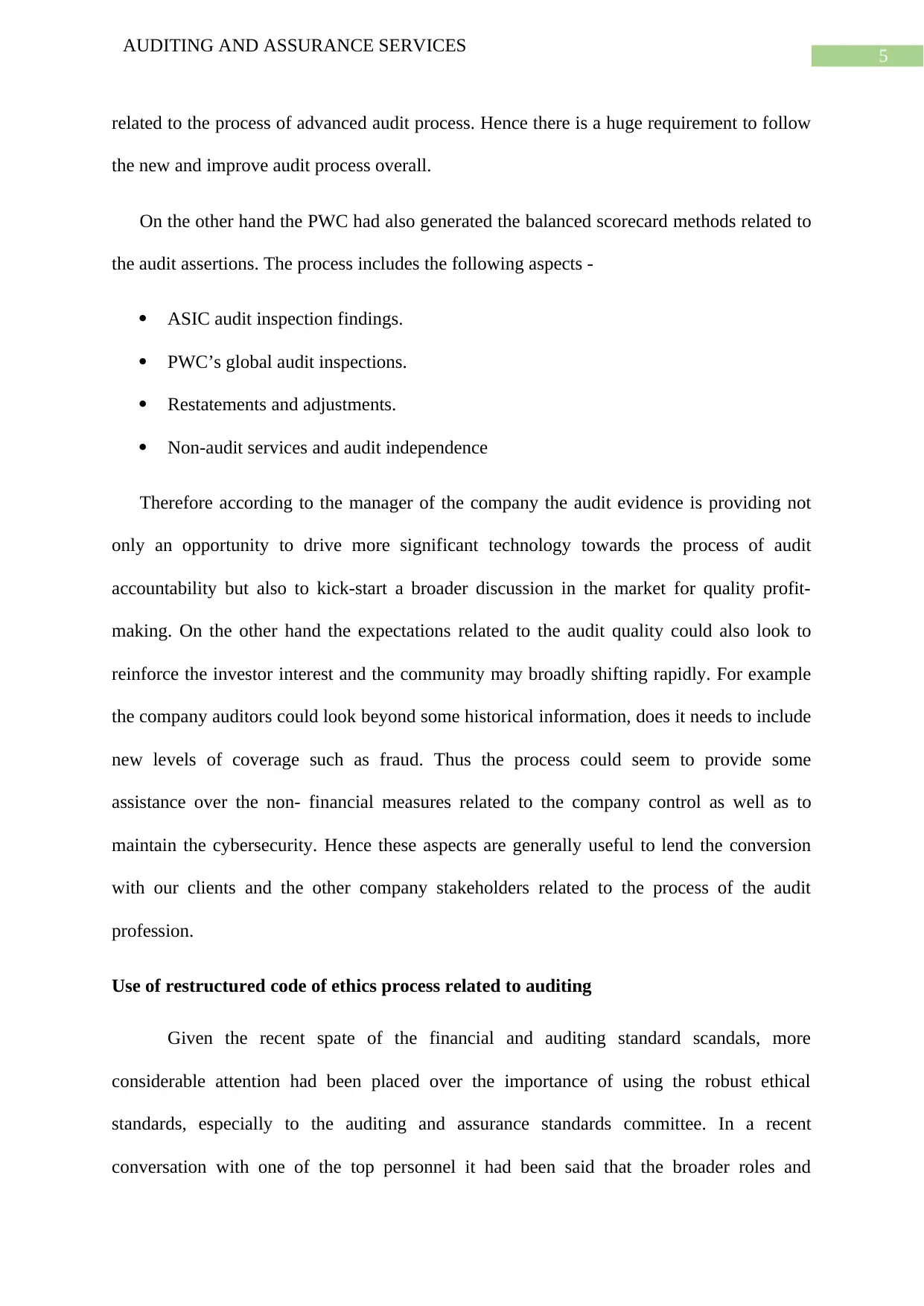
5
AUDITING AND ASSURANCE SERVICES
related to the process of advanced audit process. Hence there is a huge requirement to follow
the new and improve audit process overall.
On the other hand the PWC had also generated the balanced scorecard methods related to
the audit assertions. The process includes the following aspects -
ASIC audit inspection findings.
PWC’s global audit inspections.
Restatements and adjustments.
Non-audit services and audit independence
Therefore according to the manager of the company the audit evidence is providing not
only an opportunity to drive more significant technology towards the process of audit
accountability but also to kick-start a broader discussion in the market for quality profit-
making. On the other hand the expectations related to the audit quality could also look to
reinforce the investor interest and the community may broadly shifting rapidly. For example
the company auditors could look beyond some historical information, does it needs to include
new levels of coverage such as fraud. Thus the process could seem to provide some
assistance over the non- financial measures related to the company control as well as to
maintain the cybersecurity. Hence these aspects are generally useful to lend the conversion
with our clients and the other company stakeholders related to the process of the audit
profession.
Use of restructured code of ethics process related to auditing
Given the recent spate of the financial and auditing standard scandals, more
considerable attention had been placed over the importance of using the robust ethical
standards, especially to the auditing and assurance standards committee. In a recent
conversation with one of the top personnel it had been said that the broader roles and
AUDITING AND ASSURANCE SERVICES
related to the process of advanced audit process. Hence there is a huge requirement to follow
the new and improve audit process overall.
On the other hand the PWC had also generated the balanced scorecard methods related to
the audit assertions. The process includes the following aspects -
ASIC audit inspection findings.
PWC’s global audit inspections.
Restatements and adjustments.
Non-audit services and audit independence
Therefore according to the manager of the company the audit evidence is providing not
only an opportunity to drive more significant technology towards the process of audit
accountability but also to kick-start a broader discussion in the market for quality profit-
making. On the other hand the expectations related to the audit quality could also look to
reinforce the investor interest and the community may broadly shifting rapidly. For example
the company auditors could look beyond some historical information, does it needs to include
new levels of coverage such as fraud. Thus the process could seem to provide some
assistance over the non- financial measures related to the company control as well as to
maintain the cybersecurity. Hence these aspects are generally useful to lend the conversion
with our clients and the other company stakeholders related to the process of the audit
profession.
Use of restructured code of ethics process related to auditing
Given the recent spate of the financial and auditing standard scandals, more
considerable attention had been placed over the importance of using the robust ethical
standards, especially to the auditing and assurance standards committee. In a recent
conversation with one of the top personnel it had been said that the broader roles and
⊘ This is a preview!⊘
Do you want full access?
Subscribe today to unlock all pages.

Trusted by 1+ million students worldwide
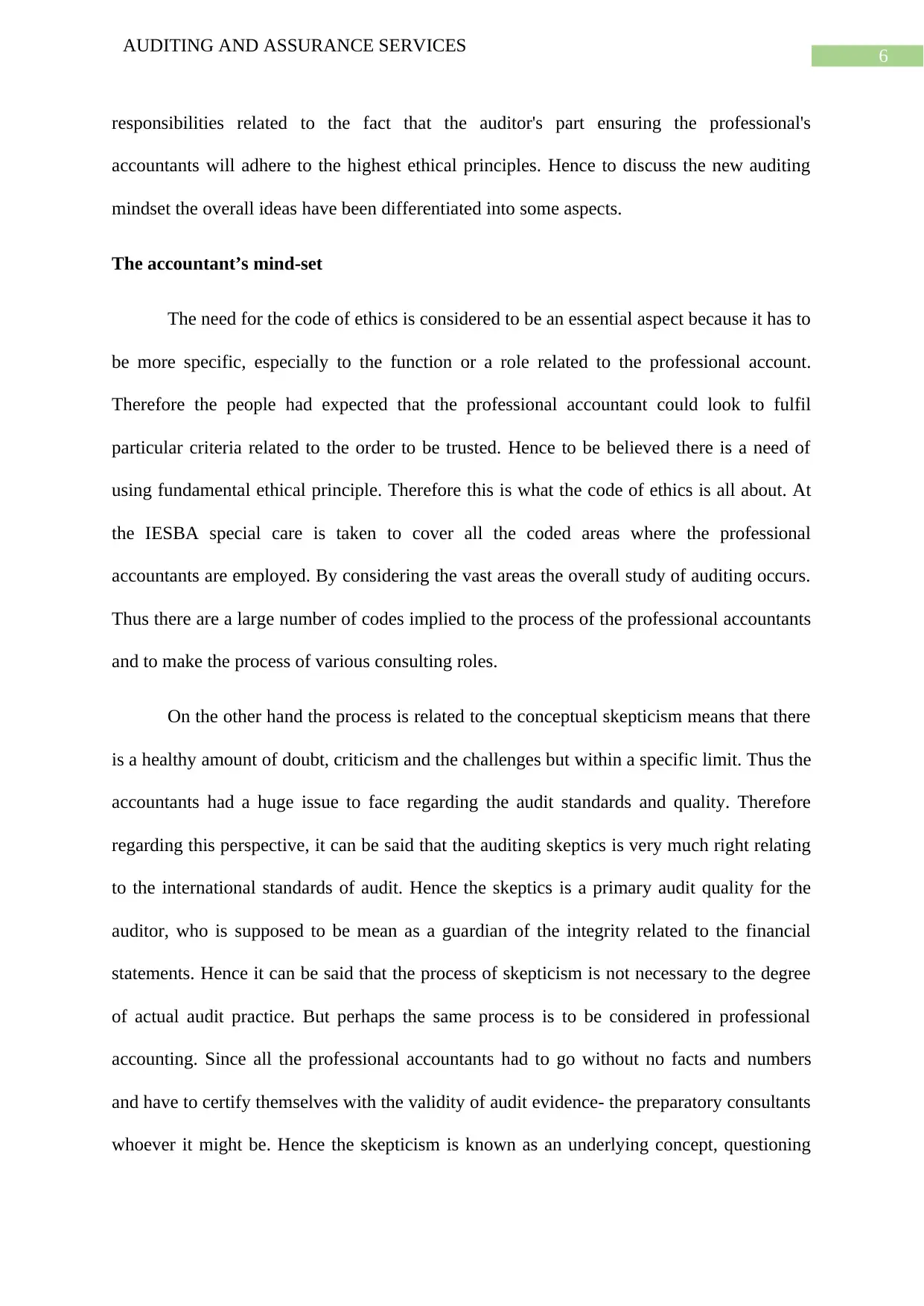
6
AUDITING AND ASSURANCE SERVICES
responsibilities related to the fact that the auditor's part ensuring the professional's
accountants will adhere to the highest ethical principles. Hence to discuss the new auditing
mindset the overall ideas have been differentiated into some aspects.
The accountant’s mind-set
The need for the code of ethics is considered to be an essential aspect because it has to
be more specific, especially to the function or a role related to the professional account.
Therefore the people had expected that the professional accountant could look to fulfil
particular criteria related to the order to be trusted. Hence to be believed there is a need of
using fundamental ethical principle. Therefore this is what the code of ethics is all about. At
the IESBA special care is taken to cover all the coded areas where the professional
accountants are employed. By considering the vast areas the overall study of auditing occurs.
Thus there are a large number of codes implied to the process of the professional accountants
and to make the process of various consulting roles.
On the other hand the process is related to the conceptual skepticism means that there
is a healthy amount of doubt, criticism and the challenges but within a specific limit. Thus the
accountants had a huge issue to face regarding the audit standards and quality. Therefore
regarding this perspective, it can be said that the auditing skeptics is very much right relating
to the international standards of audit. Hence the skeptics is a primary audit quality for the
auditor, who is supposed to be mean as a guardian of the integrity related to the financial
statements. Hence it can be said that the process of skepticism is not necessary to the degree
of actual audit practice. But perhaps the same process is to be considered in professional
accounting. Since all the professional accountants had to go without no facts and numbers
and have to certify themselves with the validity of audit evidence- the preparatory consultants
whoever it might be. Hence the skepticism is known as an underlying concept, questioning
AUDITING AND ASSURANCE SERVICES
responsibilities related to the fact that the auditor's part ensuring the professional's
accountants will adhere to the highest ethical principles. Hence to discuss the new auditing
mindset the overall ideas have been differentiated into some aspects.
The accountant’s mind-set
The need for the code of ethics is considered to be an essential aspect because it has to
be more specific, especially to the function or a role related to the professional account.
Therefore the people had expected that the professional accountant could look to fulfil
particular criteria related to the order to be trusted. Hence to be believed there is a need of
using fundamental ethical principle. Therefore this is what the code of ethics is all about. At
the IESBA special care is taken to cover all the coded areas where the professional
accountants are employed. By considering the vast areas the overall study of auditing occurs.
Thus there are a large number of codes implied to the process of the professional accountants
and to make the process of various consulting roles.
On the other hand the process is related to the conceptual skepticism means that there
is a healthy amount of doubt, criticism and the challenges but within a specific limit. Thus the
accountants had a huge issue to face regarding the audit standards and quality. Therefore
regarding this perspective, it can be said that the auditing skeptics is very much right relating
to the international standards of audit. Hence the skeptics is a primary audit quality for the
auditor, who is supposed to be mean as a guardian of the integrity related to the financial
statements. Hence it can be said that the process of skepticism is not necessary to the degree
of actual audit practice. But perhaps the same process is to be considered in professional
accounting. Since all the professional accountants had to go without no facts and numbers
and have to certify themselves with the validity of audit evidence- the preparatory consultants
whoever it might be. Hence the skepticism is known as an underlying concept, questioning
Paraphrase This Document
Need a fresh take? Get an instant paraphrase of this document with our AI Paraphraser
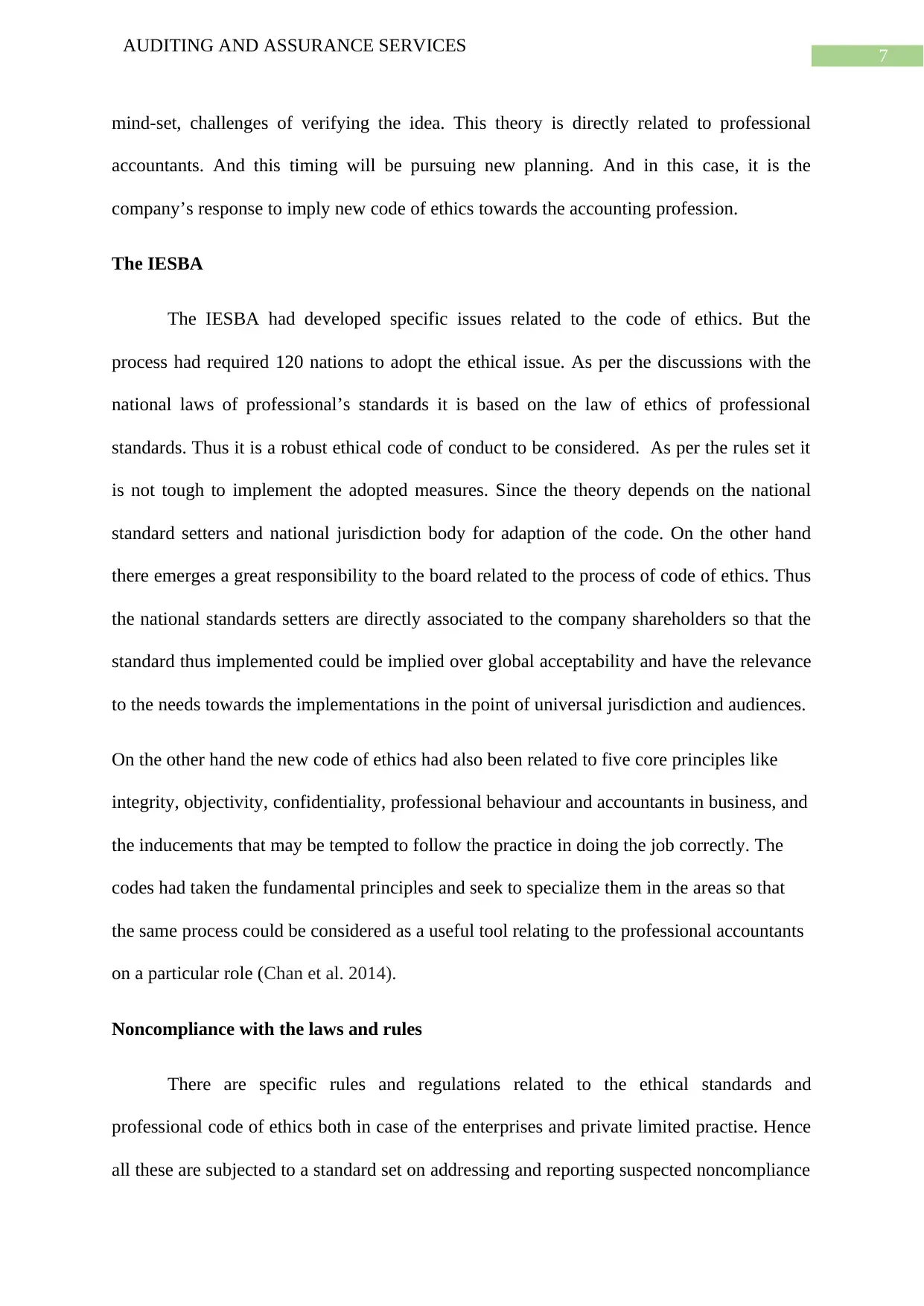
7
AUDITING AND ASSURANCE SERVICES
mind-set, challenges of verifying the idea. This theory is directly related to professional
accountants. And this timing will be pursuing new planning. And in this case, it is the
company’s response to imply new code of ethics towards the accounting profession.
The IESBA
The IESBA had developed specific issues related to the code of ethics. But the
process had required 120 nations to adopt the ethical issue. As per the discussions with the
national laws of professional’s standards it is based on the law of ethics of professional
standards. Thus it is a robust ethical code of conduct to be considered. As per the rules set it
is not tough to implement the adopted measures. Since the theory depends on the national
standard setters and national jurisdiction body for adaption of the code. On the other hand
there emerges a great responsibility to the board related to the process of code of ethics. Thus
the national standards setters are directly associated to the company shareholders so that the
standard thus implemented could be implied over global acceptability and have the relevance
to the needs towards the implementations in the point of universal jurisdiction and audiences.
On the other hand the new code of ethics had also been related to five core principles like
integrity, objectivity, confidentiality, professional behaviour and accountants in business, and
the inducements that may be tempted to follow the practice in doing the job correctly. The
codes had taken the fundamental principles and seek to specialize them in the areas so that
the same process could be considered as a useful tool relating to the professional accountants
on a particular role (Chan et al. 2014).
Noncompliance with the laws and rules
There are specific rules and regulations related to the ethical standards and
professional code of ethics both in case of the enterprises and private limited practise. Hence
all these are subjected to a standard set on addressing and reporting suspected noncompliance
AUDITING AND ASSURANCE SERVICES
mind-set, challenges of verifying the idea. This theory is directly related to professional
accountants. And this timing will be pursuing new planning. And in this case, it is the
company’s response to imply new code of ethics towards the accounting profession.
The IESBA
The IESBA had developed specific issues related to the code of ethics. But the
process had required 120 nations to adopt the ethical issue. As per the discussions with the
national laws of professional’s standards it is based on the law of ethics of professional
standards. Thus it is a robust ethical code of conduct to be considered. As per the rules set it
is not tough to implement the adopted measures. Since the theory depends on the national
standard setters and national jurisdiction body for adaption of the code. On the other hand
there emerges a great responsibility to the board related to the process of code of ethics. Thus
the national standards setters are directly associated to the company shareholders so that the
standard thus implemented could be implied over global acceptability and have the relevance
to the needs towards the implementations in the point of universal jurisdiction and audiences.
On the other hand the new code of ethics had also been related to five core principles like
integrity, objectivity, confidentiality, professional behaviour and accountants in business, and
the inducements that may be tempted to follow the practice in doing the job correctly. The
codes had taken the fundamental principles and seek to specialize them in the areas so that
the same process could be considered as a useful tool relating to the professional accountants
on a particular role (Chan et al. 2014).
Noncompliance with the laws and rules
There are specific rules and regulations related to the ethical standards and
professional code of ethics both in case of the enterprises and private limited practise. Hence
all these are subjected to a standard set on addressing and reporting suspected noncompliance
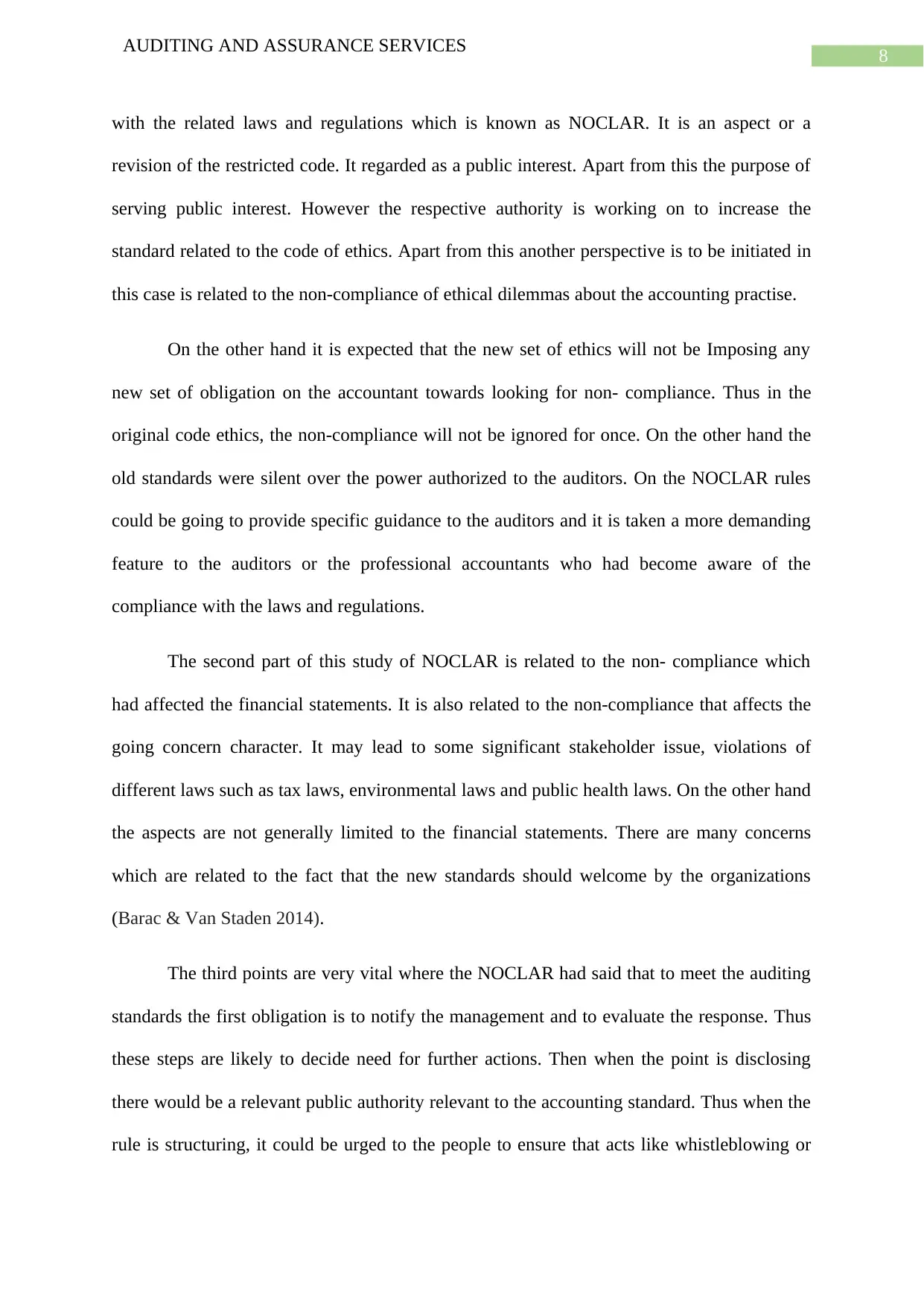
8
AUDITING AND ASSURANCE SERVICES
with the related laws and regulations which is known as NOCLAR. It is an aspect or a
revision of the restricted code. It regarded as a public interest. Apart from this the purpose of
serving public interest. However the respective authority is working on to increase the
standard related to the code of ethics. Apart from this another perspective is to be initiated in
this case is related to the non-compliance of ethical dilemmas about the accounting practise.
On the other hand it is expected that the new set of ethics will not be Imposing any
new set of obligation on the accountant towards looking for non- compliance. Thus in the
original code ethics, the non-compliance will not be ignored for once. On the other hand the
old standards were silent over the power authorized to the auditors. On the NOCLAR rules
could be going to provide specific guidance to the auditors and it is taken a more demanding
feature to the auditors or the professional accountants who had become aware of the
compliance with the laws and regulations.
The second part of this study of NOCLAR is related to the non- compliance which
had affected the financial statements. It is also related to the non-compliance that affects the
going concern character. It may lead to some significant stakeholder issue, violations of
different laws such as tax laws, environmental laws and public health laws. On the other hand
the aspects are not generally limited to the financial statements. There are many concerns
which are related to the fact that the new standards should welcome by the organizations
(Barac & Van Staden 2014).
The third points are very vital where the NOCLAR had said that to meet the auditing
standards the first obligation is to notify the management and to evaluate the response. Thus
these steps are likely to decide need for further actions. Then when the point is disclosing
there would be a relevant public authority relevant to the accounting standard. Thus when the
rule is structuring, it could be urged to the people to ensure that acts like whistleblowing or
AUDITING AND ASSURANCE SERVICES
with the related laws and regulations which is known as NOCLAR. It is an aspect or a
revision of the restricted code. It regarded as a public interest. Apart from this the purpose of
serving public interest. However the respective authority is working on to increase the
standard related to the code of ethics. Apart from this another perspective is to be initiated in
this case is related to the non-compliance of ethical dilemmas about the accounting practise.
On the other hand it is expected that the new set of ethics will not be Imposing any
new set of obligation on the accountant towards looking for non- compliance. Thus in the
original code ethics, the non-compliance will not be ignored for once. On the other hand the
old standards were silent over the power authorized to the auditors. On the NOCLAR rules
could be going to provide specific guidance to the auditors and it is taken a more demanding
feature to the auditors or the professional accountants who had become aware of the
compliance with the laws and regulations.
The second part of this study of NOCLAR is related to the non- compliance which
had affected the financial statements. It is also related to the non-compliance that affects the
going concern character. It may lead to some significant stakeholder issue, violations of
different laws such as tax laws, environmental laws and public health laws. On the other hand
the aspects are not generally limited to the financial statements. There are many concerns
which are related to the fact that the new standards should welcome by the organizations
(Barac & Van Staden 2014).
The third points are very vital where the NOCLAR had said that to meet the auditing
standards the first obligation is to notify the management and to evaluate the response. Thus
these steps are likely to decide need for further actions. Then when the point is disclosing
there would be a relevant public authority relevant to the accounting standard. Thus when the
rule is structuring, it could be urged to the people to ensure that acts like whistleblowing or
⊘ This is a preview!⊘
Do you want full access?
Subscribe today to unlock all pages.

Trusted by 1+ million students worldwide
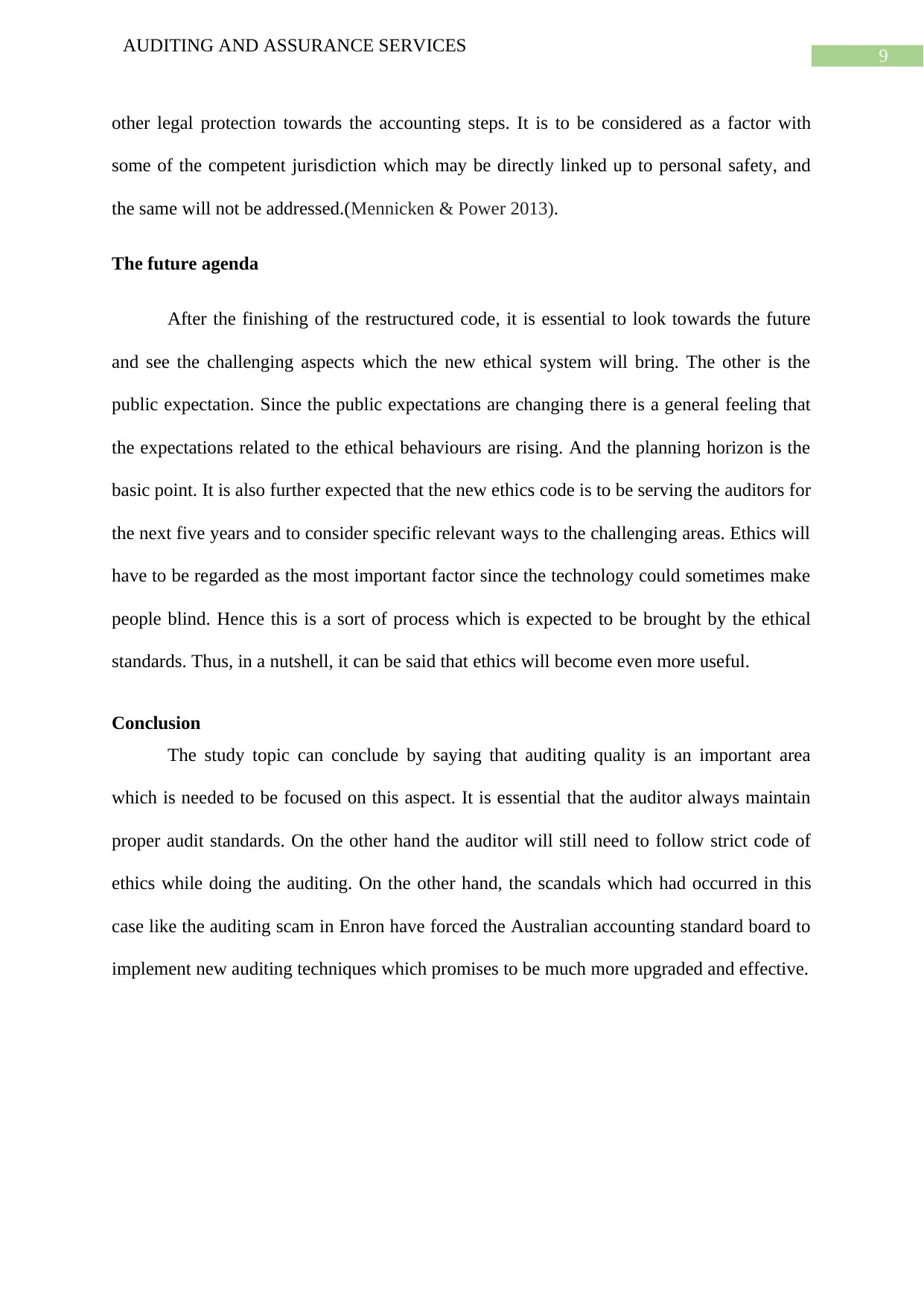
9
AUDITING AND ASSURANCE SERVICES
other legal protection towards the accounting steps. It is to be considered as a factor with
some of the competent jurisdiction which may be directly linked up to personal safety, and
the same will not be addressed.(Mennicken & Power 2013).
The future agenda
After the finishing of the restructured code, it is essential to look towards the future
and see the challenging aspects which the new ethical system will bring. The other is the
public expectation. Since the public expectations are changing there is a general feeling that
the expectations related to the ethical behaviours are rising. And the planning horizon is the
basic point. It is also further expected that the new ethics code is to be serving the auditors for
the next five years and to consider specific relevant ways to the challenging areas. Ethics will
have to be regarded as the most important factor since the technology could sometimes make
people blind. Hence this is a sort of process which is expected to be brought by the ethical
standards. Thus, in a nutshell, it can be said that ethics will become even more useful.
Conclusion
The study topic can conclude by saying that auditing quality is an important area
which is needed to be focused on this aspect. It is essential that the auditor always maintain
proper audit standards. On the other hand the auditor will still need to follow strict code of
ethics while doing the auditing. On the other hand, the scandals which had occurred in this
case like the auditing scam in Enron have forced the Australian accounting standard board to
implement new auditing techniques which promises to be much more upgraded and effective.
AUDITING AND ASSURANCE SERVICES
other legal protection towards the accounting steps. It is to be considered as a factor with
some of the competent jurisdiction which may be directly linked up to personal safety, and
the same will not be addressed.(Mennicken & Power 2013).
The future agenda
After the finishing of the restructured code, it is essential to look towards the future
and see the challenging aspects which the new ethical system will bring. The other is the
public expectation. Since the public expectations are changing there is a general feeling that
the expectations related to the ethical behaviours are rising. And the planning horizon is the
basic point. It is also further expected that the new ethics code is to be serving the auditors for
the next five years and to consider specific relevant ways to the challenging areas. Ethics will
have to be regarded as the most important factor since the technology could sometimes make
people blind. Hence this is a sort of process which is expected to be brought by the ethical
standards. Thus, in a nutshell, it can be said that ethics will become even more useful.
Conclusion
The study topic can conclude by saying that auditing quality is an important area
which is needed to be focused on this aspect. It is essential that the auditor always maintain
proper audit standards. On the other hand the auditor will still need to follow strict code of
ethics while doing the auditing. On the other hand, the scandals which had occurred in this
case like the auditing scam in Enron have forced the Australian accounting standard board to
implement new auditing techniques which promises to be much more upgraded and effective.
Paraphrase This Document
Need a fresh take? Get an instant paraphrase of this document with our AI Paraphraser
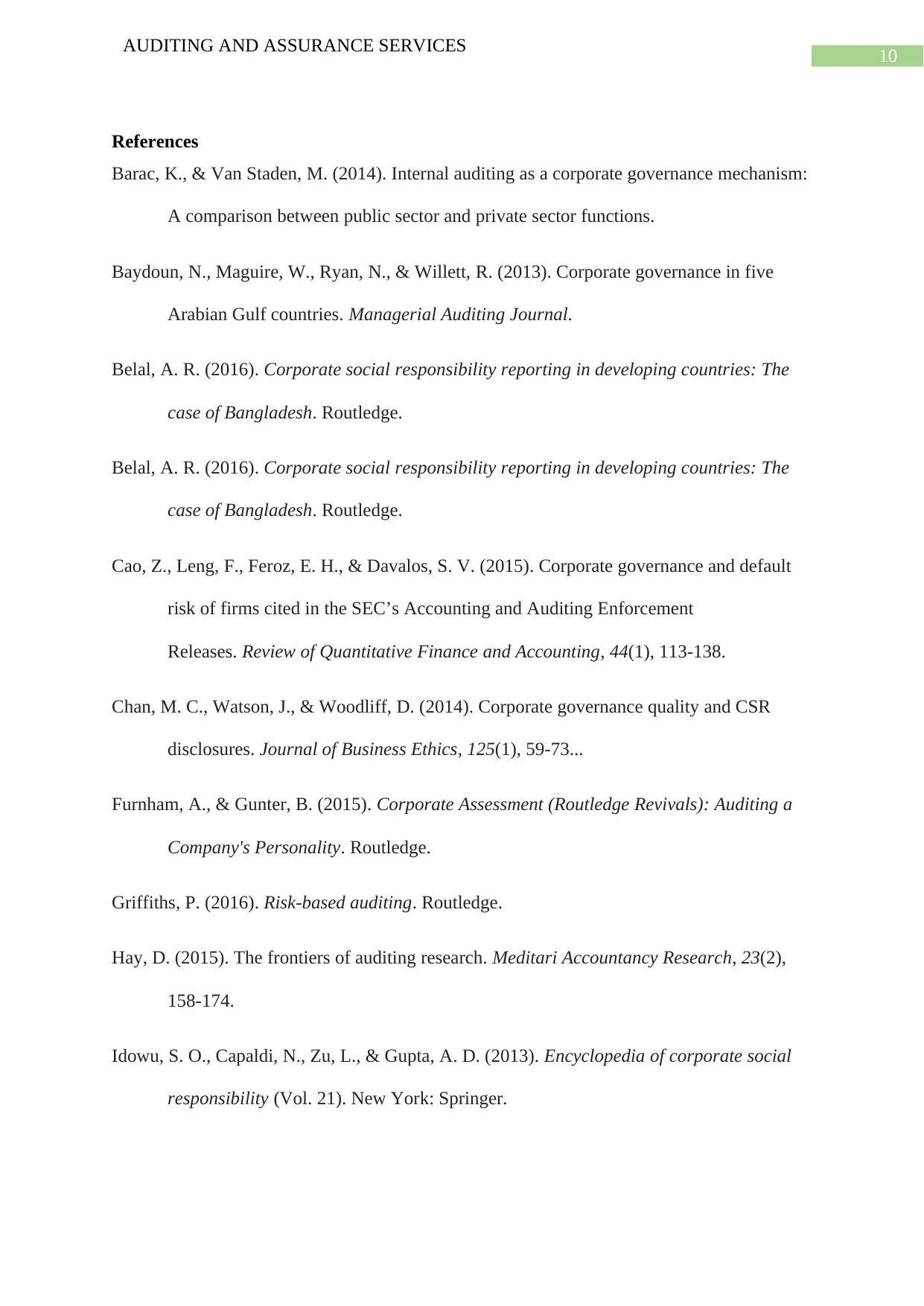
10
AUDITING AND ASSURANCE SERVICES
References
Barac, K., & Van Staden, M. (2014). Internal auditing as a corporate governance mechanism:
A comparison between public sector and private sector functions.
Baydoun, N., Maguire, W., Ryan, N., & Willett, R. (2013). Corporate governance in five
Arabian Gulf countries. Managerial Auditing Journal.
Belal, A. R. (2016). Corporate social responsibility reporting in developing countries: The
case of Bangladesh. Routledge.
Belal, A. R. (2016). Corporate social responsibility reporting in developing countries: The
case of Bangladesh. Routledge.
Cao, Z., Leng, F., Feroz, E. H., & Davalos, S. V. (2015). Corporate governance and default
risk of firms cited in the SEC’s Accounting and Auditing Enforcement
Releases. Review of Quantitative Finance and Accounting, 44(1), 113-138.
Chan, M. C., Watson, J., & Woodliff, D. (2014). Corporate governance quality and CSR
disclosures. Journal of Business Ethics, 125(1), 59-73...
Furnham, A., & Gunter, B. (2015). Corporate Assessment (Routledge Revivals): Auditing a
Company's Personality. Routledge.
Griffiths, P. (2016). Risk-based auditing. Routledge.
Hay, D. (2015). The frontiers of auditing research. Meditari Accountancy Research, 23(2),
158-174.
Idowu, S. O., Capaldi, N., Zu, L., & Gupta, A. D. (2013). Encyclopedia of corporate social
responsibility (Vol. 21). New York: Springer.
AUDITING AND ASSURANCE SERVICES
References
Barac, K., & Van Staden, M. (2014). Internal auditing as a corporate governance mechanism:
A comparison between public sector and private sector functions.
Baydoun, N., Maguire, W., Ryan, N., & Willett, R. (2013). Corporate governance in five
Arabian Gulf countries. Managerial Auditing Journal.
Belal, A. R. (2016). Corporate social responsibility reporting in developing countries: The
case of Bangladesh. Routledge.
Belal, A. R. (2016). Corporate social responsibility reporting in developing countries: The
case of Bangladesh. Routledge.
Cao, Z., Leng, F., Feroz, E. H., & Davalos, S. V. (2015). Corporate governance and default
risk of firms cited in the SEC’s Accounting and Auditing Enforcement
Releases. Review of Quantitative Finance and Accounting, 44(1), 113-138.
Chan, M. C., Watson, J., & Woodliff, D. (2014). Corporate governance quality and CSR
disclosures. Journal of Business Ethics, 125(1), 59-73...
Furnham, A., & Gunter, B. (2015). Corporate Assessment (Routledge Revivals): Auditing a
Company's Personality. Routledge.
Griffiths, P. (2016). Risk-based auditing. Routledge.
Hay, D. (2015). The frontiers of auditing research. Meditari Accountancy Research, 23(2),
158-174.
Idowu, S. O., Capaldi, N., Zu, L., & Gupta, A. D. (2013). Encyclopedia of corporate social
responsibility (Vol. 21). New York: Springer.
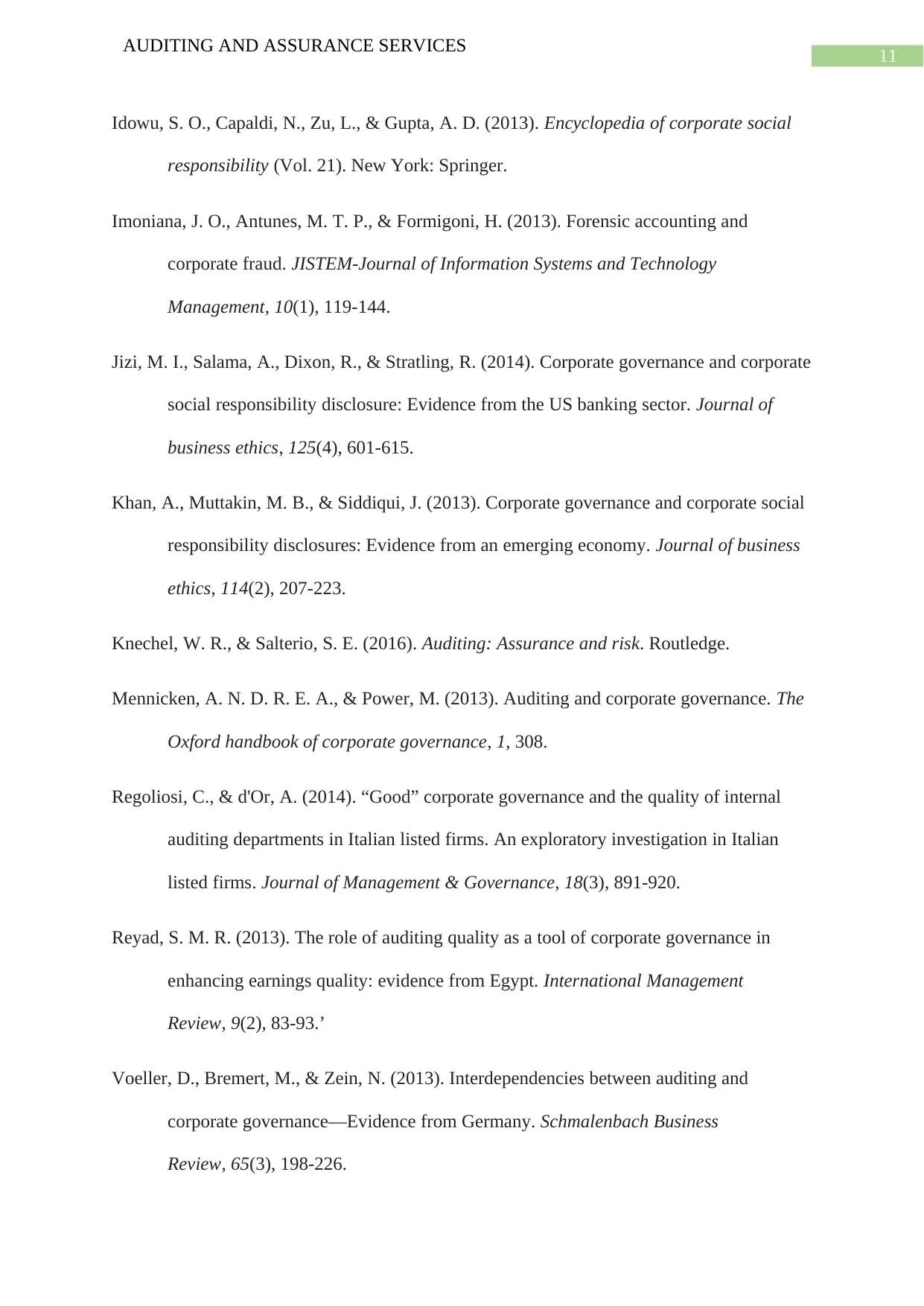
11
AUDITING AND ASSURANCE SERVICES
Idowu, S. O., Capaldi, N., Zu, L., & Gupta, A. D. (2013). Encyclopedia of corporate social
responsibility (Vol. 21). New York: Springer.
Imoniana, J. O., Antunes, M. T. P., & Formigoni, H. (2013). Forensic accounting and
corporate fraud. JISTEM-Journal of Information Systems and Technology
Management, 10(1), 119-144.
Jizi, M. I., Salama, A., Dixon, R., & Stratling, R. (2014). Corporate governance and corporate
social responsibility disclosure: Evidence from the US banking sector. Journal of
business ethics, 125(4), 601-615.
Khan, A., Muttakin, M. B., & Siddiqui, J. (2013). Corporate governance and corporate social
responsibility disclosures: Evidence from an emerging economy. Journal of business
ethics, 114(2), 207-223.
Knechel, W. R., & Salterio, S. E. (2016). Auditing: Assurance and risk. Routledge.
Mennicken, A. N. D. R. E. A., & Power, M. (2013). Auditing and corporate governance. The
Oxford handbook of corporate governance, 1, 308.
Regoliosi, C., & d'Or, A. (2014). “Good” corporate governance and the quality of internal
auditing departments in Italian listed firms. An exploratory investigation in Italian
listed firms. Journal of Management & Governance, 18(3), 891-920.
Reyad, S. M. R. (2013). The role of auditing quality as a tool of corporate governance in
enhancing earnings quality: evidence from Egypt. International Management
Review, 9(2), 83-93.’
Voeller, D., Bremert, M., & Zein, N. (2013). Interdependencies between auditing and
corporate governance—Evidence from Germany. Schmalenbach Business
Review, 65(3), 198-226.
AUDITING AND ASSURANCE SERVICES
Idowu, S. O., Capaldi, N., Zu, L., & Gupta, A. D. (2013). Encyclopedia of corporate social
responsibility (Vol. 21). New York: Springer.
Imoniana, J. O., Antunes, M. T. P., & Formigoni, H. (2013). Forensic accounting and
corporate fraud. JISTEM-Journal of Information Systems and Technology
Management, 10(1), 119-144.
Jizi, M. I., Salama, A., Dixon, R., & Stratling, R. (2014). Corporate governance and corporate
social responsibility disclosure: Evidence from the US banking sector. Journal of
business ethics, 125(4), 601-615.
Khan, A., Muttakin, M. B., & Siddiqui, J. (2013). Corporate governance and corporate social
responsibility disclosures: Evidence from an emerging economy. Journal of business
ethics, 114(2), 207-223.
Knechel, W. R., & Salterio, S. E. (2016). Auditing: Assurance and risk. Routledge.
Mennicken, A. N. D. R. E. A., & Power, M. (2013). Auditing and corporate governance. The
Oxford handbook of corporate governance, 1, 308.
Regoliosi, C., & d'Or, A. (2014). “Good” corporate governance and the quality of internal
auditing departments in Italian listed firms. An exploratory investigation in Italian
listed firms. Journal of Management & Governance, 18(3), 891-920.
Reyad, S. M. R. (2013). The role of auditing quality as a tool of corporate governance in
enhancing earnings quality: evidence from Egypt. International Management
Review, 9(2), 83-93.’
Voeller, D., Bremert, M., & Zein, N. (2013). Interdependencies between auditing and
corporate governance—Evidence from Germany. Schmalenbach Business
Review, 65(3), 198-226.
⊘ This is a preview!⊘
Do you want full access?
Subscribe today to unlock all pages.

Trusted by 1+ million students worldwide
1 out of 13
Related Documents
Your All-in-One AI-Powered Toolkit for Academic Success.
+13062052269
info@desklib.com
Available 24*7 on WhatsApp / Email
![[object Object]](/_next/static/media/star-bottom.7253800d.svg)
Unlock your academic potential
Copyright © 2020–2025 A2Z Services. All Rights Reserved. Developed and managed by ZUCOL.





